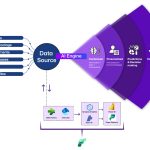Dynamic pricing is a flexible pricing strategy in which the price of a product or service is changed in real time based on various factors such as demand, supply, market conditions, and other external variables. Unlike traditional fixed pricing, dynamic pricing allows companies to dynamically adjust their pricing to maximize revenue or achieve specific business goals.
Read More: Unleashing the Power of Accessibility Testing | Practical Applications of Generative AI in IT Infrastructure
Industries Using Dynamic Pricing
Various industries have embraced dynamic pricing strategies to adapt to market changes and optimize revenue. Some notable examples include:
-
E-commerce:
Online retailers frequently adjust prices based on factors such as demand, inventory levels, and competitor pricing. Companies like Amazon use dynamic pricing algorithms to optimize product prices in real-time.
-
Sports and Entertainment:
Ticket prices for sporting events, concerts, and theater performances often vary based on factors like the popularity of the event, seat location, and timing. Dynamic pricing helps maximize revenue for organizers.
-
Technology:
Software-as-a-Service (SaaS) providers frequently use dynamic pricing to offer tiered subscription plans based on usage, features, and the number of users. This allows customers to choose plans that best fit their needs.
Dynamic Pricing Models
There are four main dynamic pricing models or strategies that businesses can use to increase sales and revenue:
-
Price skimming:
This strategy involves setting high prices for a new product or service to maximize revenue from early adopters.
-
Penetration pricing:
This strategy involves setting low prices for a new product or service to attract as many customers as possible.
-
Price discrimination:
This strategy involves charging different prices to different customer groups based on location, time of purchase, or demographics.
-
Bundling:
This strategy involves packaging products or services at a discounted price.
Read More: How Early Adopters of Generative AI Are Winning with Personalization
Integrating AI in Dynamic Pricing: The Foundation
In an ever-evolving business environment, businesses are increasingly turning to artificial intelligence (AI) and machine learning as cornerstones to develop dynamic pricing strategies. The foundational role of AI in this context is revolutionary, marking a departure from traditional pricing models to a more adaptive and responsive approach.
At its core, AI empowers businesses with the capability to process and analyze vast datasets, incorporating factors such as market trends, consumer behavior, competitor pricing, and external variables.
Machine learning algorithms play a pivotal role in this transformation. By continually learning from historical data, these algorithms enable businesses to predict demand fluctuations, identify emerging patterns, and dynamically adapt pricing strategies. This predictive capability is the linchpin of dynamic pricing, providing companies with the agility to optimize pricing structures based on actual market dynamics rather than relying on fixed assumptions.
In essence, the foundation of integrating AI in dynamic pricing lies in its ability to automate processes, provide real-time insights, and enable businesses to navigate the intricacies of a dynamic market. The result is a pricing strategy that is not only adaptive and data-driven but also positions businesses at the forefront of competitiveness in an increasingly complex business environment.

Ethical and Regulatory Considerations: Balancing Profit and Responsibility
As businesses increasingly embrace dynamic pricing strategies to maximize profitability, a critical examination of the ethical dilemmas and regulatory frameworks surrounding this practice becomes imperative. While dynamic pricing offers a range of benefits, including enhanced revenue optimization and market responsiveness, its implementation raises ethical questions related to fairness, transparency, and consumer trust.
Ethical concern revolves around the potential for price discrimination. Dynamic pricing, driven by algorithms and data analytics, may inadvertently lead to varying prices for different individuals or groups. This raises questions about fairness and equitable access to goods and services. Striking a balance between offering personalized pricing to meet market demand and ensuring fairness is a delicate challenge.
Transparency is another ethical consideration. Consumers often find it disconcerting when prices fluctuate without apparent reason. Businesses need to communicate clearly about the factors influencing dynamic pricing, fostering trust and transparency in their customer relationships. Providing consumers with insights into the data points and algorithms influencing pricing decisions can help alleviate concerns and build confidence.
The ethical and regulatory considerations surrounding dynamic pricing go beyond immediate financial gains. Businesses must weigh the short-term profit potential against the long-term impact on brand reputation and customer relationships.
Read More: Generative AI for Business expansion | Key Components of an Intelligent Data and AI Platform
Case Study: Optimizing Food Retail through Dynamic Pricing Strategies
In the ever-evolving landscape of food retail, where consumer preferences and market trends continuously shift, adaptability and responsiveness have become essential. Dynamic pricing has emerged as a crucial tool for food retailers to optimize revenue, maintain competitiveness, and elevate overall customer satisfaction.
Background:
Facing challenges in perishable inventory management, revenue optimization, and offering competitive pricing in a dynamic market, my client in the food retail sector sought innovative solutions.
Dynamic Pricing Implementation:
To tackle these challenges, we implemented a dynamic pricing system infused with AI and machine learning capabilities. Our approach considered various factors to tailor the strategy to the unique needs of our client:
-
Seasonal Demand:
Prices were adjusted based on the demand for specific fresh produce, meats, and other perishables during different seasons, ensuring a strategic response to market fluctuations.
-
Trend Analysis:
Real-time data analysis was utilized to identify popular and trending food items, allowing for flexible pricing adjustments in alignment with customer preferences and market trends.
-
Competitor Pricing:
Continuous monitoring of competitors’ pricing strategies ensured competitiveness while maximizing profitability, allowing our client to strategically position themselves in the market.
-
Inventory Levels:
Perishable goods were dynamically priced to prevent waste, encourage sales, and optimize inventory turnover, contributing to sustainable and responsible inventory management.
Results:
The implementation of dynamic pricing on our client’s website produced tangible and impactful outcomes:
-
Maximized Revenue:
By adjusting prices based on demand fluctuations, our client’s supermarket experienced maximized revenue during peak seasons, holidays, and special events.
-
Reduced Food Waste:
Smart pricing decisions based on real-time inventory levels significantly minimized perishable food waste, leading to substantial cost reductions.
-
Enhanced Customer Experience:
Personalized discounts and promotions, driven by dynamic pricing algorithms, resulted in increased customer engagement and loyalty. Shoppers felt they were receiving enhanced value for their money.
-
Competitive Edge:
Regular analysis of competitor pricing ensured our client’s website maintained a competitive position in the market, adapting swiftly to changes in the pricing landscape and reinforcing their market presence.
This case study exemplifies the successful optimization of food retail through the strategic implementation of dynamic pricing strategies. By leveraging AI and machine learning, our client achieved not only financial gains but also a strengthened market position and enhanced customer loyalty. This dynamic approach showcases the power of innovation in navigating the complexities of the food retail industry and ensuring sustained success in a rapidly changing market.
Read More: Power of Cloud-Based Time Attendance Systems for Modern Enterprises
Cultivating Trust: Dynamic Pricing and Customer Relationships
In the realm of dynamic pricing, establishing and maintaining customer trust is paramount. Transparency and ethical practices play pivotal roles in fostering loyalty, creating a symbiotic relationship between businesses and their customers. When implemented conscientiously, dynamic pricing can align with customer-centric strategies, enhancing the overall customer experience.
-
Transparent Communication:
Open communication about the principles and mechanisms of dynamic pricing is fundamental. Businesses should articulate how prices are determined, emphasizing the dynamic nature of the strategy based on factors like demand, inventory, and market conditions.
-
Fairness in Pricing:
Ethical considerations in dynamic pricing involve ensuring fairness. Implementing reasonable price ranges and avoiding exorbitant surges during peak demand periods contribute to customer satisfaction.
-
Loyalty Programs and Discounts:
Dynamic pricing can be integrated with loyalty programs and personalized discounts to demonstrate commitment to customer value. Offering exclusive deals or rewards to loyal customers creates a sense of reciprocity, reinforcing the idea that the business values its customer relationships beyond mere transactions.
-
Opt-In and Opt-Out Features:
Granting customers the ability to opt in or opt out of dynamic pricing features enhances their control over their purchasing decisions. This customization empowers customers, instilling a sense of autonomy and trust in the pricing process.
-
Data Privacy and Security:
Respecting customer privacy and securing their data is a critical ethical consideration. Clearly communicating how customer data is used and protected builds trust. An emphasis on stringent data security practices fosters a sense of confidence among customers that their information is handled responsibly.
-
Continuous Improvement:
Dynamic pricing strategies should be continuously refined based on customer feedback and market trends. Businesses that actively seek and respond to customer input demonstrate a commitment to improvement and customer satisfaction, further solidifying trust.
Read More: Discover the Power of Drupal 10 | NopCommerce – The Ultimate Complete Guide

Looking Ahead: Future Trends in E-commerce Pricing
As we peer into the future of e-commerce pricing, it becomes evident that dynamic pricing is poised to undergo further evolution, driven by advancements in technology and shifting consumer expectations. Several trends are likely to shape the landscape of pricing strategies in the e-commerce realm.
-
Hyper-Personalization:
Future dynamic pricing models will delve deeper into hyper-personalization. AI and machine learning algorithms will increasingly analyze individual customer behavior, preferences, and purchase history to tailor pricing in real-time.
-
Sustainability Considerations:
Ethical and sustainability considerations are expected to play a more prominent role in dynamic pricing. Consumers are becoming increasingly conscious of the environmental impact of their purchases.
-
Augmented Reality (AR) Integration:
The integration of augmented reality into the e-commerce experience will influence dynamic pricing. AR technologies can provide customers with immersive product experiences, and dynamic pricing may adapt based on the level of engagement with AR features.
-
Real-Time Marketplaces:
The rise of real-time marketplaces will reshape how dynamic pricing operates. Platforms that facilitate instant buying and selling of goods will require pricing algorithms that can swiftly respond to market dynamics.
-
Subscription-Based Pricing Models:
Subscription-based pricing models are anticipated to gain traction. E-commerce businesses may move beyond traditional one-time purchases, incorporating dynamic pricing within subscription services.
-
Blockchain for Transparent Pricing:
Blockchain technology may be integrated to enhance transparency in dynamic pricing. Smart contracts and decentralized ledgers can provide a secure and transparent record of pricing decisions, addressing concerns related to fairness and trust.
The future of dynamic pricing in e-commerce holds exciting possibilities. As technology continues to advance, businesses will increasingly leverage data-driven insights to create highly personalized and ethical pricing strategies.
Read More: Microsoft Dynamics 365 and nopCommerce
Dynamic Pricing Summary
As we’ve seen, the price is not firmly set. It changes depending on the type of product, industries, market conditions, demand in a certain year’s time, and of course, on the type of customer being targeted.
As we navigate the dynamic pricing landscape, it is crucial to strike a balance between profit optimization and competitive pricing.
What are your perspectives on pricing strategies? Feel free to share your thoughts with us; we value your insights!











